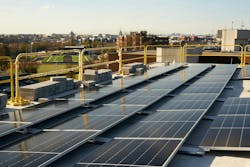Scale Microgrids’ 500-MW Community Solar Deal Seen as Opportunity to Add Value to Microgrids
Scale Microgrids has inked a 500-MW community solar deal, partnering with developer Gutami on a multistate project that includes energy storage in California, where Scale hopes the state’s community solar legislation (AB 2316) to be approved with a minimum of four hours of storage capacity.
“We're excited about the California market right now. The California community solar program that is being finalized will be the first that requires all facilities to be paired with a minimum of four hours of storage capacity,” said Nicole Green, director of marketing and branding at Scale Microgrids. “The co-location of battery storage aligns nicely with our microgrid business,” she added.
Deal provides 500 MW across four states
The community solar will be located in California, New York state and two other unnamed states. Under the deal, Scale Microgrids will build, own and operate projects developed by Gutami in the four states. Scale Microgrids will also provide financing through its Capital Solutions arm. The arrangement builds on last year’s agreement with Gutami to finance, build, own and operate 100 MW of community solar projects in New York state.
“The announcements are getting bigger and bigger because community solar is getting so big,” said Julian Torres, chief investment officer at Scale Microgrids.
Providing options for microgrid customers
Scale Microgrids is especially interested in community solar because it can add value for microgrid customers, he said. In general, a microgrid customer’s site won’t have a solar footprint – relative to load -- that maximizes the amount of solar companies can use, said Torres.
“By having a community solar portfolio across the nation, we’re creating more optionality for customers,” said Torres.
Wood Mackenzie forecasts that existing community solar markets will increase by an average of 8% annually with nearly 14 GW of cumulative capacity expected by 2028.
Inflation Reduction Act, state programs and utility interest drive growth
Growth in community solar is driven by a number of factors, including an increasing number of state programs, utility interest and the Inflation Reduction Act (IRA), said Torres. More than half of the states in the U.S. have community solar programs.
Many of the IRA’s policies provide benefits to projects below 5 MW. In addition, utilities are more willing to engage with community solar than other behind-the-meter resources, he said.
“Community solar allows the value stream to pass through utilities’ rate- based customers,” Torres said. “What we’re seeing is a preference for policies that allow consumers to participate in solar if they don’t have the highest credit score or don’t want to participate in financing,” he said.
And it’s easier for consumers to go green with community solar.
“Community solar subscribers have an easier entry point into community solar and the green energy benefits associated with that,” Torres said.
In addition, the push against net metering by states makes community solar more attractive than adding rooftop solar. And landowners are recognizing that community solar can create value streams through leasing or selling lands for community solar projects. What’s more, communities that host community solar projects can reap tax revenues that help out schools and community agencies.
“These are generally 5-MW projects that are very manageable developments and the impact to communities is more manageable than large utility-scale projects,” Torres said.
Gallaudet University combines microgrid with community solar
Scale’s microgrid at Gallaudet University in Washington, D.C., is an example of how microgrids can be combined with community solar. With the Gallaudet microgrid, additional solar capacity will be made available to D.C. residents through the Community Renewable Energy Facility Program. This additional solar capacity will generate enough renewable electricity to meet the needs of 1,500 households or small businesses in D.C., said Green.
Gallaudet University Microgrid part of content at our 2024 Conference
Happening April 22-24 in Baltimore: Early registration available now
The arrangement tracks the electricity produced from distributed solar panels connected to Gallaudet’s campus and then allocates the output as community solar credits.
Interconnection challenges can slow community solar development
While the number of community solar projects is increasing, one obstacle can slow their development: interconnection delays.
“The key challenge boils down to the volume of interconnection applications that utilities often receive when a community solar program, in particular, first opens – and the diminishing hosting capacity associated with that,” said Samantha Weaver, director of interconnection and grid integration policy at the Coalition for Community Solar Access during a conference organized by the Interstate Renewable Energy Council in the fall of 2023.
Once a community solar program opens, there’s a big influx of interest and the available hosting capacity disappears quickly, she added. For example, Illinois expanded its program capacity to 450 MW but has a waitlist of 1.5 GW from previous years.
Getting in the queue early
Ryan Goodman, CEO of Scale Microgrids, said the company works to act early and partner with experienced developers to address interconnection challenges.
“That’s why we like working with partners who are engaged in the process,” he said. Scale Microgrids tries to get into the interconnection queue as early as possible and work with developers who know how to get through the process efficiently.
Off-grid microgrids avoid interconnection delays
One way to avoid interconnection hassles is to go off grid. Scale Microgrids is developing an off-grid microgrid for a cold storage facility in California.
Meanwhile, the company sees an opportunity to develop community solar facilities that help out both utilities and their customers.
“As the grid becomes less reliable, these small community-sited distribution grid sites will help bolster the grid and provide more access to clean, cheap electricity by guaranteeing discounts on utility bills,” said Green.








